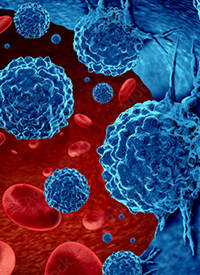News
Article
Oral Decitabine and Cedazuridine Wins EU Approval for Newly Diagnosed AML
Author(s):
The European Commission has approved oral decitabine and cedazuridine for the treatment of adult patients with newly diagnosed acute myeloid leukemia who are ineligible for standard induction chemotherapy.
EU Approves Decitabine and Cedazuridine in AML |
Image Credit: ©freshidea - stock.adobe.com

The European Commission has approved oral decitabine and cedazuridine (Inaqovi) for the treatment of adult patients with newly diagnosed acute myeloid leukemia (AML) who are ineligible for standard induction chemotherapy.1
The regulatory decision was supported by data from the phase 3 ASCERTAIN trial (NCT03306264), which showed that oral decitabine and cedazuridine had pharmacokinetic exposure equivalence to a standard 5-day regimen of intravenous (IV) decitabine (Dacogen), meeting the trial’s primary end point. Patients treated with the oral formulation experienced a pharmacokinetic exposure equivalence of 99.64% (90% CI, 91.23%-108.8%) compared with IV decitabine.
In North America, the multicenter, randomized, open-label ASCERTAIN trial enrolled patients at least 18 years of age with myelodysplastic syndrome (MDS) previously treated or untreated with de novo or secondary MDS, chronic myelomonocytic leukemia (CMML), or intermediate-1–, intermediate-2–, or high-risk MDS. In Europe, the study enrolled patients with de novo or secondary AML who were not candidates for standard induction chemotherapy.2
All patients were required to have an ECOG performance status of 0 or 1, adequate organ function, and a life expectancy of at least 3 months. Patients were excluded if they received prior treatment with more than 1 cycle of azacitidine (Vidaza) or decitabine. Prior cytotoxic chemotherapy was not allowed for patients with AML, except for hydroxyurea to control high white blood cell counts.
During the study, 89 patients with AML were randomly assigned 1:1 to receive 35 mg of oral decitabine plus 100 mg of oral cedazuridine in cycle 1, followed by 20 mg/m2 of IV decitabine in cycle 2 (n = 44), or the reverse sequence (n = 45).1 Both the oral regimen and IV decitabine were given once daily on days 1 to 5 of each 28-day cycle. Beginning in cycle 3, all patients received oral decitabine plus oral cedazuridine on days 1 to 5, and treatment continued until disease progression, death, or unacceptable toxicity.
Along with the primary end point of pharmacokinetic exposure equivalence, key secondary end points included overall survival (OS) and safety.
Additional data showed that at a median follow-up of 7.95 months, patients with AML achieved a median OS of 7.9 months (95% CI, 5.9-13.0) and a complete response (CR) rate of 21.8%.
Regarding safety, findings for the fixed-dose combination of decitabine and cedazuridine were generally consistent with the known safety profile for IV decitabine. Thrombocytopenia was the most common adverse effect. The most common serious AEs reported in at least 20 % of patients included febrile neutropenia and pneumonia. AEs led to permanent treatment discontinuation in 14% of patients, and the most common AE leading to permanent discontinuation was pneumonia (5%).
Additional data from ASCERTAIN showed that in patients with intermediate- or high-risk MDS, including CMML (n = 133), the oral combination of decitabine and cedazuridine produced a median OS of 31.7 months (95% CI, 28.0-not evaluable [NE]).3 Additionally, this patient population experienced an overall response rate of 61.7% (95% CI, 52.8%-69.9%) and a CR rate of 22% (95% CI, 15.1%-29.8%). The median leukemia-free survival was 29.1 months (95% CI, 22.1-NE).
These data from ASCERTAIN helped support the FDA approval of the oral combination of decitabine and cedazuridine for the treatment of adult patients with MDS in July 2020.4
References
- Otsuka and Astex announce that the European Commission has approved Inaqovi (oral decitabine and cedazuridine) for the treatment of adults with newly diagnosed acute myeloid leukaemia. News release. Otsuka Pharmaceutical Europe and Astex Pharmaceuticals. September 19, 2023. Accessed September 19, 2023. https://www.businesswire.com/news/home/20230919732476/en/
- Study of ASTX727 vs IV decitabine in MDS, CMML, and AML. ClinicalTrials.gov. Updated September 5, 2023. Accessed September 19, 2023. https://classic.clinicaltrials.gov/ct2/show/NCT03306264
- Astex Pharamceuticals presents overall survival data from ASCERTAIN phase 3 study of oral hypomethylating agent Inqovi (decitabine and cedazuridine) in MDS and CMML at International Congress on Myelodysplastic Syndromes. News release. Astex Pharmaceuticals. September 23, 2021. Accessed September 19, 2023. https://astx.com/astex-pharmaceuticals-presents-overall-survival-data-from-ascertain-phase-3-study-of-oral-hypomethylating-agent-inqovi-decitabine-and-cedazuridine-in-mds-and-cmml-at-international-congress-on/
- FDA approves oral combination of decitabine and cedazuridine for myelodysplastic syndromes. News release. FDA. July 7, 2020. Accessed September 19, 2023. https://www.fda.gov/drugs/resources-information-approved-drugs/fda-approves-oral-combination-decitabine-and-cedazuridine-myelodysplastic-syndromes








